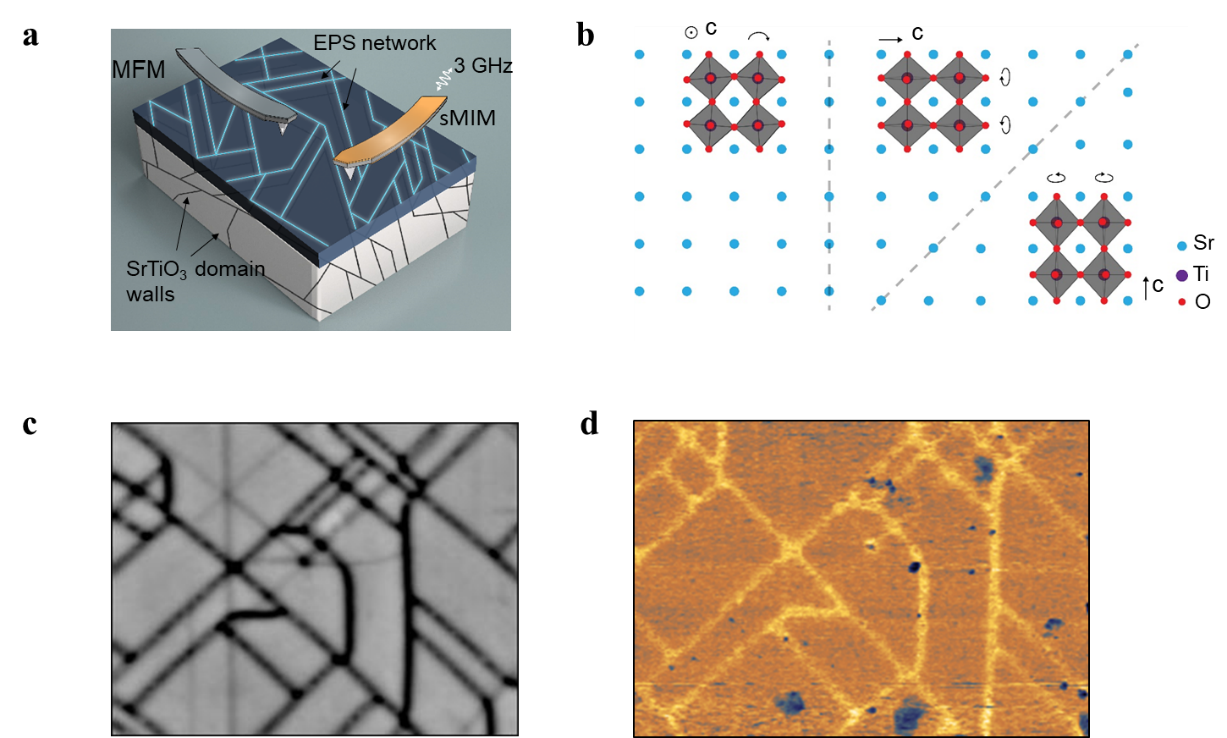A new research conducted by our group reported a local strain manipulation of electronic phase separation (EPS) in manganite superlattice LaMnO3/PrMnO3/CaMnO3 thin film. This was a collaboration with Prof. Hongjun Xiang and Prof. Changlin Zheng from Fudan University. The results were published online in Nature Communications on November 3, 2022, entitled with “Electronically phase separated nano-network in antiferromagnetic insulating LaMnO3/PrMnO3/CaMnO3 tricolor superlattice”.
As a prototypical strongly correlated system, manganite received research interests from the academia for its colossal magnetoresistance (CMR), i.e., its resistivity dramatically changes by up to 9 orders of magnitude under an external magnetic field. Over years of experimental and theoretical studies, people have identified a close relation between CMR and EPS. The interaction between electron spin, charge, orbital and lattice degrees of freedom leads to rich electronic phases with energy in close in manganite. They coexist and compete in a large portion of the phase diagram. For example, in manganite (La1-yPry)1-xCaxMnO3 (LPCMO) system, there exists a microscopic EPS of ferromagnetic metallic (FMM) and antiferromagnetic insulating phase (AFM-I). The applied external magnetic field drives a phase transition from AFM-I to FMM resulting in an increase of FMM phase volume. When such a FMM phase volume exceeds a threshold value, an insulator to metal transition happens because a spatial percolation of a conducting network occurs. As a consequence, the resistivity is greatly reduced underlying the CMR of manganite.
An intriguing character of EPS in manganite LPCMO is its micro-meter length scale. Such a large-scale EPS is energetically not favorable because a spatial variation of electron density at the micro-meter scale will significantly increase the Coulomb interaction energy of the system. The origin of this large-scale EPS in LPCMO is thus under heavy investigations. Elbio Dagotto and his collaborators point out that, the chemical disorder of the A-site ion in LPCMO is responsible for this large-scale EPS (Physical Review Letters,84, 5568 (2000)). Specifically, the variation of A-site ion’s radius among La, Pr and Ca will affect the bond angle of Mn-O-Mn, which has an influence on the electron hopping and the magnetic exchange in the system and ultimately leads to a large-scale EPS. Since 2008, our group has been working on the LPCMO manganite system, especially on the physical origin of its large-scale EPS as well as the manipulation. Using pulsed laser deposition (PLD) technique, we develop a method to grow LPCMO superlattice so as to control the A-site ion disorder in a very accurate way. These studies reveal that the length scale of EPS state will decrease from micro- to nano-meter when the A-site ion disorder is suppressed (Nature Communications,7, 11260 (2016)). More importantly, EPS state is gone in a LaMnO3/PrMnO3/CaMnO3 tricolor superlattice when such a chemical disorder is completely removed (PNAS,117, 7090-7094 (2020)). We thus directly demonstrate the A-site ion chemical disorder as the physics origin of a large-scale EPS in LPCMO.
Our group also develop various external approaches (electric field, magnetic field and strain field) to achieve a spatially confined manipulation of EPS state in LPCMO, with a goal to ultimately design and pattern EPS state at will. As mentioned above, the interplay between electron spin, charge, orbital and lattice degrees of freedom in manganite facilitates such EPS state manipulation because the system tends to sensitively respond to different external stimuli even it only affects one degree of freedom. For example, strain can change the global transport and magnetic state of manganite although it apparently affects the lattice degree of freedom in the system.
We recently reported a local strain manipulation of EPS state in LPCMO superlattice resulting in a nano-network of EPS state completely different from previous studies. As shown in Fig. 1a, we grow a LaMnO3/PrMnO3/CaMnO3 tricolor superlattice thin film on a SrTiO3 (STO) substrate by PLD. Consistent with previous report, such a superlattice has AFM-I as its spatially uniform ground state without EPS. However, as the temperature is lower, a 2D nano-network appears in the system. Further studies show that, such a 2D nano-network is closely related to the structure transition of STO at 105 K from a cubic to a tetragonal phase. This structural transition gives rise to a spatial pattern of the structural domain wall (Fig. 1b). The superlattice thin film experiences a different strain at the domain wall from its counterpart within the domain. To accommodate this spatially varied strain state, the LaMnO3/PrMnO3/CaMnO3 superlattice thin film develops a similar 2D nano-network to release the extra tensile strain from the STO substrate. We use magnetic force microscopy (MFM) and scanning microwave impedance microscopy (sMIM) to characterize the local magnetic and transport state of such a 2D nano-network (Fig. 1c and d). These imaging results confirm a local FMM phase at the domain wall. First principle calculations indicate that the system will transit from AFM-I to FMM phase if the tensile strain is released. This work demonstrates LaMnO3/PrMnO3/CaMnO3 tricolor superlattice as a highly tunable EPS system. More importantly, this system responds to an external strain in a very local manner which is different from disordered thin films. Building on such a local strain manipulation of EPS state, one can fully control the spatial pattern of EPS state by properly designing and applying the strain.

Fig. 1 (a) The LaMnO3/PrMnO3/CaMnO3 tricolor superlattice grown on SrTiO3 substrate. (b) The structural domain wall of SrTiO3 at low temperature. (c) MFM imaging reveals ferromagnetic order at the domain wall. (d) sMIM imaging reveals conducting character at the domain wall.
Paper link: https://doi.org/10.1038/s41467-022-34377-4